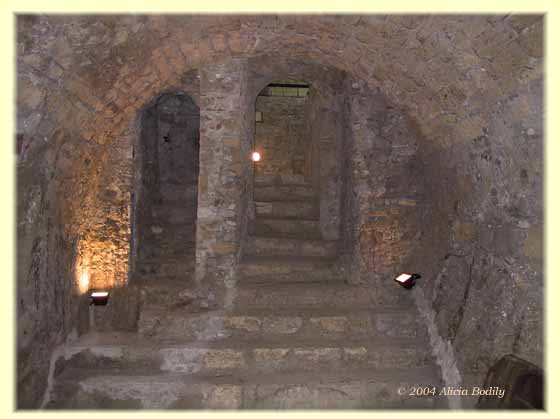The Arbëreshë of Calabria: Stories
Page 1
Village Stories

|
Ç'u bë, u bë; ç'u tha, u tha*
"Llargu fikut, Zot!" A certain man wanted to know whether his wife really loved him or not, so he played dead. He was placed in a coffin, and his friends cried for him. He was breathing very, very lightly. His wife also pretended to be sad with apparent sorrow. As time went by, he began to get scared, but he said nothing. After the funeral, the cortege gathered to take him to the cemetery, and the man began his journey with the coffin uncovered, as was the custom. So, as the coffin came near a fig tree by the side of the road, he jumped up and held on to the trunk as hard as he could. His wife saw this, and pretended to be happy because her husband was still alive. After a while, he really died. Again they put him in the coffin. When the time came, his relatives and friends started walking to the cemetery with the coffin's lid open. When the woman saw that they were coming closer to the fig tree, she called the priest that headed the procession, shouting, -"Llargu fikut, Zot! T'e mos të bënjë si vjet!" ("Away from the fig tree, priest! So he won't do like last year!") Láhrgoo feécoot, z[as in "zoo"]ót! téh móhs t' bá["nun"]hn[i] [as in niah, niah, niah, niaaah, niah!] see viét! Narrator: Emanuele Giordano - Proverb found in "Zëri i Arbrëshvet" N. 14 |
Coffins, as a precaution, remained open in church, while the funeral took place, and five or six hours after the deceased was taken to the cemetery. Until the '30s of the last century, helpful women could be seen carrying under their arm the coffin of a friend's baby to the cemetery, accompanied by family and friends. If the deceased was from Eianina, regardless of age, the cortege started from the church of San Basilio Magno. From there, it went toward Frascineto, through the main street, via Roma, then it passed in front of the church of Santa Maria Assunta, and finally to the cemetery, which was (and is) about 400 yards away. The photo above shows the crypt of the church of Santa Maria del Colle in Mormanno, province of Cosenza. The dead were lowered into the crypt by opening a trap door that originally was made of wood, now replaced with transparent glass (See the top of the right hand stairs). The opening is located immediately in front and to the right of the main altar. The crypt served as tomb and ossuary. The bones found in the crypt have been transferred to the local cemetery. In the past, if a church had a crypt, such as San Pietro in Frascineto, once the funeral was over, and after verifying that the person was really dead, the trap door was opened, and the coffin was lowered (or dumped, as the crypt filled up) on top of the others that were already there. Only those who belonged to a higher social standing were buried under the pavement in particular spots in the church, or in the altars. Cemeteries were usually located around the perimeter of the church. Lime was commonly used to prevent infections. Some people were also buried in the fields. In the areas of Santa Lucia, Santa Barbara and at other locations, water jars have been found beside the graves, along with other personal objects of the deceased. (Sources: Papas Emanuele Giordano of Eianina, Don Peppino Oliva of Mormanno, personal church visits, photographic documentation, information from the local parish registers, notary records.) |

|
Moti shkon e hera qaset*
A coffin for two It was a cold day. A man had just been at the cemetery church in Frascineto, finding the open coffin of a recently deceased man. He soon met his friends, and he told them that someone had to close the coffin with the big nail. -"Who's capable of going to the cemetery to nail the lid shut?" --"I'm going to nail the lid shut!", said one of them. He put on his cloak, took a big nail and a hammer, and went to the cemetery. Once he was there, feeling somewhat frightened, he started hammering the nail at the foot of the coffin. In his anxiety to finish the task as soon as possible, he didn't realize that the rim of his cloak had slipped under the nail, thus leaving it anchored on the coffin as well. As soon as he finished, he started walking away, feeling the tug of the cloak toward the coffin! He became so frightened that he nearly died, but catching his breath, he ran away as quickly as his legs permitted, all the while believing that the deceased wanted to keep the cloak for himself. Narrator: Emanuele Giordano - Proverb found in "Zëri i Arbrëshvet" N. 14 |
© 2004 Alicia Bodily
Todos los derechos reservados. Prohibida su reproducción total o parcial.
